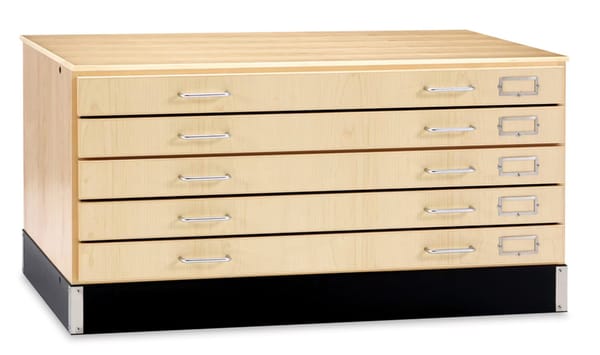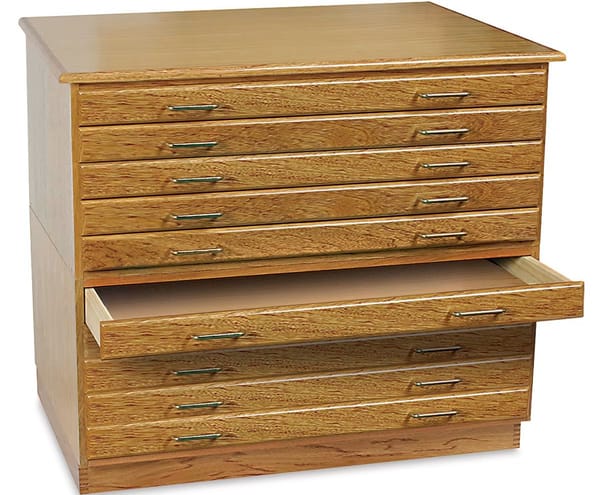5 Drawer Flat File Cabinet: A Complete Buying and Setup Guide
Keep artwork and documents flat with a 5 Drawer Flat File Cabinet - durable, wide storage perfect for studios, classrooms, and offices.

A 5-drawer flat file cabinet gives you serious storage without taking over your floor plan, keeping large sheets perfectly flat, easy to sort, and safely protected. Whether you manage a busy studio, an architecture office, or a classroom with rotating projects, the right cabinet turns piles into a clean, professional archive that speeds your work and preserves your best pieces.
What Is a 5 Drawer Flat File Cabinet?
A 5-drawer flat file cabinet is a low, wide cabinet with five shallow, full-extension drawers for storing large papers and boards completely flat. In contrast to vertical filing systems, where weight rests on the top and bottom of papers, the weight of flat files is distributed over the entire sheet. Typical footprints are built around common formats such as 18×24, 24×36, 30×42, and A-series sizes, while internal clearances hover around two inches, enough room for interleaving sheets, folders, and rigid backers. The result is gentle handling, quick retrieval, and consistent protection for drawings, watercolours, prints, photographs, blueprints, maps, and presentation boards that should never be folded or rolled.
Why Choose a 5 Drawer Model Over Others?
The 5-drawer flat file model is the perfect compromise of usable volume, ergonomic height, and floor or shelf space that fits under all windows. Three-drawer stacks may not be large enough to keep projects or media separate, while ten-drawer towers can be tall, heavy, and overwhelming when placed in compact rooms. With five drawers, you get real sorting power without compromising access or stability, and you can always stack a second unit later with a riser base for counter-height work.
Quick comparison and use cases
- Versus 3-drawer: more separation by medium or project, better working height, similar footprint.
- Versus 10-drawer: easier to move or reconfigure, less visual bulk, simpler for shared spaces.
- Studios: editioned prints, mixed paper sizes, flat storage for in-progress work.
- Offices: plan sets, construction documents, presentation graphics, marketing posters.
- Classrooms: portfolios, charts, laminated materials, student projects by course or term.
Key Features to Look for
The best five drawer flat file cabinet combines durable materials, smooth drawer mechanics, sensible security, and a modular design that lets you expand as your archive grows. You must focus on building quality in the case and slides, the right drawer depth, and features that protect fragile surfaces during daily use and frequent access. Here are some key features described below:
Material: Steel vs. Wood
- Steel: Highly durable, stackable, easy to wipe clean; ideal for busy studios, schools, and shared spaces. Powder-coated finishes resist scratches and scuffs.
- Wood: Furniture-grade look that blends with desks and gallery interiors; great for client-facing rooms and home studios. Choose sealed finishes and quality slides.
Drawer Depth and Glide System
- Depth: Around 2" internal clearance supports interleaving sheets, Mylar or glassine, and rigid backers without snagging.
- Glides: Ball-bearing or equivalent slides should offer full extension and stay square under load, protecting edges and preventing jams.
- Support: Even bottom support across the drawer reduces sagging with heavy stacks or mounted work.
Locking Mechanism and Security
- Central lock or per-drawer locks for sensitive plans, student exams, pre-release designs, or valuable artwork.
- Lockable bases or casters help in shared environments or rooms that reconfigure frequently.
Stackability and Modularity
- Add-on stacks let you place a second 5-drawer cabinet on top for instant capacity.
- Riser bases raise the unit to counter height, add toe clearance, and create a practical work surface.
- Alignment hardware (corner guides or tabs) keeps stacked units stable and square.
Best Uses of 5-Drawer Flat Files by Profession
A well-chosen 5-drawer flat file cabinet improves daily flow in creative, technical, and educational settings by protecting surfaces and keeping retrieval fast and predictable.
Artists & Designers
Flat files preserve fragile surfaces and make pulling work for framing, photography, or client meetings painless.
- Separate drawers by medium charcoal, watercolour, screenprint, ink, and interleave friable media with glassine.
- Keep small pieces in folders or sleeves inside larger drawers so nothing slides under heavier sheets.
- Use the cabinet top (with a riser base) as a clean layout bench for edits and proofing.
Architects & Engineers
Plan sets remain flat, legible, and ready for quick collation during reviews or site meetings.
- Label drawers by project, phase, or discipline (A, S, MEP) for instant access.
- Stage current sets in the top drawer and archive previous issues below.
- Keep a one-page index card on the side of the cabinet for at-a-glance navigation.
Educators & Collectors
Central, flat storage protects posters, charts, large photos, and vintage papers from creasing and light exposure.
- Use archival sleeves for delicate or irreplaceable items.
- Create sign-out sheets or a simple digital log for class use or lending.
- Sort by course, year, or collection for quick retrieval before lessons or exhibits.
Top 5 Drawer Flat File Cabinets to Consider in 2025
The best options pair smooth drawer action with dependable builds and stackable growth, so you can start practical and expand when your archive outgrows a single cabinet.
Safco 5-Drawer Steel Flat Files
- Why choose it: Welded-steel strength, reliable slides, protective features that keep edges and surfaces safe during daily use.
- Who it's for: Busy studios, schools, and production environments that open drawers all day.
- Good to know: Offered in footprints aligned to common formats; easy to stack with matching bases.
Safco Facil Flat Files
- Why choose it: Value-focused steel cabinet with labelable drawers and clean operation at a friendlier price point.
- Who it's for: Classrooms, shared studios, budget-conscious teams that still need dependable flat storage.
- Good to know: Lighter overall footprint; straightforward to start and build up over time.
Diversified Spaces Flat File System
- Why choose it: Furniture-grade wood construction that looks at home in design offices, galleries, and client-facing spaces.
- Who it's for: Studios that want warm aesthetics without sacrificing practical storage.
- Good to know: Check finish options and slide specs for smooth, full-extension access.
Hann Mobile Paper Storage Cart
- Why choose it: Mobility for rooms that reconfigure daily; keep work near presses, printers, or teaching stations.
- Who it's for: Classrooms, labs, and project rooms needing storage that moves with the task.
- Good to know: Verify wheel locks and stability; a strong companion to a stationary flat file.
How to Maintain Your 5 Drawer Flat File Cabinet
Regular, gentle maintenance keeps drawers gliding, documents clean, and finishes looking professional, extending the life of both the cabinet and your collection.
- Cleaning and humidity control: Wipe steel surfaces with a soft, barely damp cloth and dry immediately; dust wood finishes gently. Keep relative humidity moderate and stable to prevent paper cockling or adhesive failure.
- Preventing rust or drawer jams: Vacuum beneath and behind the unit to limit dust migration. Clear debris from slides instead of forcing a sticky drawer. Distribute weight evenly to avoid twisting tracks.
- Periodic inspection and lubrication: Each quarter, check labels, slide action, and lock performance. Apply a manufacturer-approved lubricant sparingly to slides if needed. Replace glassine or sleeves that show smudging or yellowing.
Setup Tips: Get It Right on Day One
Thoughtful setup protects your collection from the start and saves headaches later when capacity grows or rooms change.
- Measure the route: Confirm doorways, corridors, and elevator clearances before delivery.
- Plan the footprint: Allow full drawer extension and safe standing room in front; leave space at the sides for handling and label reading.
- Level the base: Use shims if needed to level cabinets, glide better, and reduce long-term wear.
- Label immediately: Size, series, date range, or project codes; add a master drawer map on the cabinet side.
- Protect sensitive media: Interleave friable works with glassine and fold small pieces so they don't slide under larger sheets.
- Think ergonomics: Pair stacked 5-drawer units with a riser base if you plan to use the top as a layout surface.
Final Thoughts
A 5-drawer flat file cabinet is the sweet spot for most studios, offices, and classrooms because it offers real sorting power in a manageable package that supports daily work. Choose materials and slides that match your workload, plan the footprint for full-extension access, and label from day one so retrieval is fast and consistent. With steady maintenance, controlled climate, and smart interleaving, your cabinet will protect drawings, prints, plans, and posters for years. This maintenance will turn storage into a reliable part of your creative or professional routine rather than a daily challenge.




